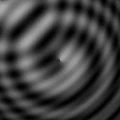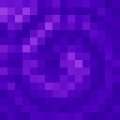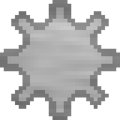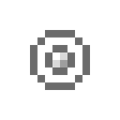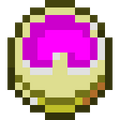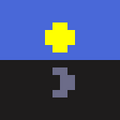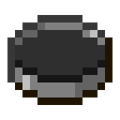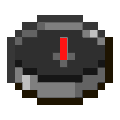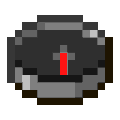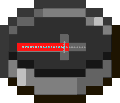Prior to Java Edition 1.5 snapshot 13w02a,[more information needed] the textures for animated blocks were generated on-the-fly using certain algorithms, rather than being defined image files.
In cases such as when the texture could not be loaded, dedicated placeholder textures would be loaded instead.
Blocks[]
Fire[]
Nether portals[]
Due to the large number of Atan2 and Sine operations, all frames of animation (a total of 32, at a resolution of 16×16) for the portal block are generated once at-startup and stored into an internal animation strip; The random shimmer is the same every time, as the game always uses a random number generator with a seed of 100L.
To generate one frame of the nether portal animation:
# assume time is a value from 0 to 1; a value of 1 will result in
# the same image as a time value of 0 (excluding the random shimmering effect)
def setup_portal_sprite (time: float, output: Image):
random = Random(100)
wide, tall = output.size
for x in range(wide):
for y in range(tall):
n = 0.0
for dir in range(2):
# All in this loop is done twice to create two spirals,
# one of which offset to the topright
spiral_x = (x - dir * (wide // 2)) / wide * 2.0
spiral_y = (y - dir * (tall // 2)) / tall * 2.0
spiral_x += 2 if spiral_x < -1 else -2 if spiral_x >= 1 else 0
spiral_y += 2 if spiral_y < -1 else -2 if spiral_y >= 1 else 0
mag = spiral_x ** 2.0 + spiral_y ** 2.0
out_spiral = atan2(spiral_y, spiral_x)
# Mag is used here to make the arms of the spiral constrict
# the further from the centre of the spiral they are
out_spiral += ((time * pi * 2) - (mag * 10) + (dir * 2)) * (dir * 2 - 1)
# `(i * 2 - 1)` will reverse the direction of the spiral if is 0
# `* 0.5 + 0.5` will bring the spiral into the range of 0 to 1 rather than -1 to 1
out_spiral = sin(out_spiral) * 0.5 + 0.5
# make the intensity of the spiral's arms diminish with distance from the centre
out_spiral /= mag + 1
# divide by two so that the final range is 0 to 1 instead of 0 to 2,
# as we're generating two spirals
n += out_spiral / 2
n += random.range(0.0, 0.1) # make the spirals shimmer slightly at random
r = int(n ** 2 * 200 + 55)
g = int(n ** 4 * 255)
b = int(n * 100 + 155)
output.set_pixel(x, y, r, g, b, b) # blue is used for transparency
The portal block is the only one of the procedural textures that is ported 1:1 in the 1.5 resource pack changes; Unlike the water animations, the alpha channel was not made uniform in the 1.15 texture update.
Gears[]
Code which generates the frames of the gear texture can be found here.
The animation for gears was generated using two predefined image files - misc/gear.png for the rotating gear and misc/gearmiddle.png for the stationary center.
The animation, updated every game tick,[1] is rendered as a 16×16 texture like most other blocks. The resulting gear has 18.75 RPM.[1]
There are two different animations used for gears - one for clockwise rotation, and another for anticlockwise rotation, to allow for logical meshing. These are generated effectively identically, with the only difference being the direction of rotation; both start on the same frame, but cycle through them in the opposite direction.[1]
Fluids[]
Fluid textures are generated via 3-layer non-deterministic cellular automata, which modify the RGB and alpha values of the texture accordingly,[2] along with shifting of the texture to emulate flowing. Each layer is represented as an array of floats, each with 256 elements, corresponding to the 256 (16x16) texture pixels within the block.[2]
As can be seen when loading up a world with water or lava in view, the textures start as a solid color before the cellular automaton starts generating the texture.
Indexes which end up outside of the bounds of the texture reappear at the opposite respective side.[2]
For the purposes of explanation, the variables used have been named (arbitrarily) as attributes of a boiling pot of soup over a fire.[2] The first layer represents the flame_heat value (which can be either negative or positive), the second layer represents the pot_heat value and the third layer represents the soup_heat value.
Note that Java Edition and Bedrock Edition used different pseudorandom generators for generating all random numbers in the game (Java Edition using a LCG whereas Pocket Edition used a MT19937), which includes the random numbers used for water and lava. Due to being random, however, this likely has negligible visual impact.
Water[]
Still water[]
Adapted from https://github.com/UnknownShadow200/ClassiCube/wiki/MInecraft-Classic-lava-animation-algorithm#water
Every frame, for each position in the still water texture array, the respective values for soup_heat, pot_heat and flame_heat are calculated as detailed below:
Calculates a local_soup_heat equal to the sum of the 3x1 soup_heat neighborhood around the current element.Calculates the new soup_heat as the sum of the local_soup_heat divided by 3.3F plus the pot_heat times 0.8FCalculates the new pot_heat as the current pot_heat plus the flame_heat times 0.05. pot_heat is clamped to a minimum of 0.Calculates the new flame_heat as the current flame_heat minus 0.1F.However, there is a 0.05 in 1 random chance that flame_heat is set to 0.5.
Once the above arrays have been updated, for each pixel in the water texture, the color and alpha values are calculated based on soup_heat:
Calculates a color_heat as the soup_heat clamped between 0 and 1 inclusive.Then it calculates the color components of the pixel as follows:float red = 32 + color_heat^2 * 32float green = 50 + color_heat^2 * 64float blue = 255float alpha = 146 + color_heat^2 * 50
The red, green and blue values are then converted to bytes and assigned to the texture accordingly.
Flowing water[]
In addition, the flowing water texture also uses a spatial translation to give the appearance of movement. This transformation moves the flowing water texture downwards by one pixel after a fixed amount of time,[more information needed] wrapping the bottom layer of the texture back to the top.
Lava[]
Still lava[]
Adapted from https://github.com/UnknownShadow200/ClassiCube/wiki/MInecraft-Classic-lava-animation-algorithm#lava
Every frame, for each position in the still water texture array, the respective values for soup_heat, pot_heat and flame_heat are calculated as detailed below:
Calculates a local_soup_heat equal to the sum of the 3x3 soup_heat neighborhood around the current element but offset vertically by colSin******* and offset horizontally by rowSin*********.rowSin is 1.2 times the sign of an angle that starts at 0 and changes by 22.5 degrees every row.colSin is 1.2 times the sign of an angle that starts at 0 and changes by 22.5 degrees every column.
Calculates a local_pot_heat equal to the sum of a 2x2 pot_heat neighborhood around the current pot_heat, with the current position being the upper left of the 2x2 neighborhood.Calculates the new soup_heat as the sum of the local_soup_heat divided by 10 plus the local_pot_heat divided by 4 times 0.8.Calculates the new pot_heat as the current pot_heat plus the flame_heat times 0.01***************. pot_heat is clamped to a minimum of 0.Calculates the new flame_heat as the current flame_heat minus 0.06.However, there is a 0.005 in 1 random chance that flame_heat is set to 1.5.
Once the above arrays have been updated, for each pixel in the lava texture, the color values are calculated based on soup_heat (alpha is always opaque for lava):
Calculates a color_heat as double the soup_heat clamped between 0 and 1 inclusive.Then it calculates the color components of the pixel as follows:float red = color_heat * 100F + 155Ffloat green = color_heat^2 * 255Ffloat blue = color_heat^4 * 128F
The red, green and blue values are then converted to bytes and assigned to the texture accordingly.
Flowing lava[]
Flowing lava uses the exact same texture as still lava, however there is also a spatial translation to give the appearance of movement. This transformation moves the lava texture downwards by one pixel after a fixed amount of time,[more information needed] wrapping the bottom layer of the texture back to the top.
Items[]
Clocks[]
To generate its appearances, the clock combined 2 textures, one being the actual clock, and the other being the dial.
The logic solely for mixing the two (as there is additional logic for moving the dial in a wobbly fashion that isn't pertinent here) is as follows:
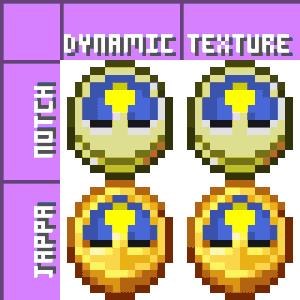
The procedural and pre-rendered clocks compared. The difference in precision is far more obvious in-game. If the modern clock sprite were to be procedurally generated it would only have 218 unique frames, as the window to the dial is slightly different.
# Assume RGBA values are handled as 0.0 to 1.0 float values
def setup_clock_sprite (item: Image, dial: Image, dial_angle: float, output: Image):
rx = sin(-dial_angle)
ry = cos(-dial_angle)
for y in range(item.height):
for x in range(item.width):
pix = item.get_pixel(x, y)
if pix.r == pix.b and pix.g == 0 and pix.b > 0:
u: float = -(x / (item.width - 1) - 0.5)
v: float = y / (item.height - 1) - 0.5
dial_pix = dial.get_pixel(
int(((u * ry + v * rx + 0.5) * dial.width)) % dial.width,
int(((v * ry - u * rx + 0.5) * dial.height)) % dial.height
)
dial_pix.rgb *= pix.r
pix = dial_pix
output.set_pixel(x, y, pix)
This results in the item and dial sprites being mixed by fuchsia areas of the clock sprite, as well as being shaded by them (contrary to the popular belief that they were mixed solely on the two shades found on the vanilla sprite). This allowed for the clock to be animated precisely, having 230 visually distinct frames, in an era where block and item sprites couldn't be animated individually without mods. The pre-rendered animated approach, used in 1.5 onwards, is far less precise, with only 64 different frames.
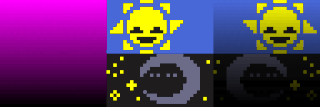
A valid albeit silly clock sprite, showing how the fuchsia areas are used to mix the sprite and dial; Note how the dial gets flipped horizontally.
Due to an oversight with how assets were loaded however, the item sprite for clocks couldn't be overridden by texture packs (as they are set to always load from the vanilla gui/items.png atlas, stored in minecraft.jar, rather than the one of the currently active texture pack.
Compasses[]
Compasses simply draw two lines over the item sprite to form the needle.
Much like clocks, the code responsible for moving the needle is also present with the "setup" code, however it is omitted here as it is not pertinent to the actual drawing of the sprite. Also like clocks, an oversight in how the compass sprite is set to be loaded prevents texture packs from overriding the compass's base sprite.
def setup_compass_sprite (item: Image, angle: float, output: Image):
NX = 8.5
NY = 7.5
SCALE_X = 0.3
SCALE_Y = SCALE_X * 0.5
# copy the item's texture into the output
for i, pix in enumerate(item):
output.set_pixeli(i, pix)
rx = sin(angle)
ry = cos(angle)
# draw the smaller horizontal spurs of the needle
# 1 is added to the endpoint, as `range` here is
# end-exclusive. The original loops did `i <= 4`
for i in range(-4, 4 + 1):
x = int(NX + ry * i * SCALE_X)
y = int(NY - rx * i * SCALE_Y)
output.set_pixel(x, y, '#646464')
# draw the main part needle
for i in range(-8, 16 + 1):
x = int(NX + rx * i * SCALE_X)
y = int(NY + ry * i * SCALE_Y)
if i >= 0:
# Main red pointer
output.set_pixel(x, y, '#FF1414')
else:
# Grey back half
output.set_pixel(x, y, '#646464')
The generated compass sprite has 102 possible unique frames, while the pre-rendered compass has significantly less, at only 32 frames.




